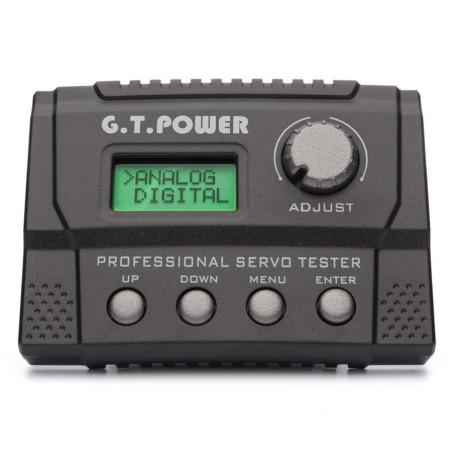The professional servo tester is used for testing digital and analog servos and measuring the width of control pulses. It generates a control pulse signal with a logic level "1" of 5.0V with a repetition rate of 50 Hz (for analog servos) or 100 Hz (for digital servos). Four buttons and a dial are used to control the device; program menus and measured values are displayed on a two-line LCD. The profi servo tester has seven basic operating modes:
- Manual servo position adjustment using the knob (control pulse width range basic 1000-2000 µs/extended 500-2500 µs). You can use this function to test the linearity of the servo movement and its operation in general. You can also use it to test electronic speed controllers
- Automatic cyclic testing of servo movement with adjustable number of cycles, deflection range and coasting speed. This function is primarily used to test the long-term service life of the servo mechanism
- Servo testing with switchable 1000, 1500 and 2000 µs fixed position buttons. This function is mainly used to test and mechanically set the neutral position of the rudder and to test the accuracy of the servo's return to the center position during movement from both sides
- Measurement of servo insensitivity band. This function is mainly used to test the insensitivity band of the servo and determine its actual resolution. It is also useful if you need multiple servos responding in exactly the same way - typically, e.g., 2-4 CCPM servos of a spinning board, multiple servos controlling the same or paired rudders in model aircraft (especially in extreme 3D with large deviations)
- Measurement of servo movement speed at 60° bend
- Automatic testing of servo movement with adjustable deflection range and coasting speed. This function is mainly used to test the smoothness of servo movement; it highlights, for example, defects or operational wear in the resistance track of the feedback potentiometer (manifested by vibrations or jerks), mechanical damage to the gears (missing teeth), etc
- Measurement of the width of control pulses from an external source (such as a receiver). This function is primarily used to test the control pulses at the servo outputs from the receiver. You can measure the width of the pulse at a certain transmitter setting, and also test the stability of the control pulse width (whether the servo shakes, oscillates or drifts without changing the position of the controls on the transmitter), etc.
The sockets on the right are for powering the servo - either the JST-XH socket for connecting the service connector of a 2S LiPo (7.4V) battery, or the coaxial connector for connecting a 7.4-12V battery or AC power supply. The servo supply voltage at the servo tester's output (SIGNAL/OUT) is stabilized at 5 V regardless of the device's supply voltage.
The servo under test is connected to the SIGNAL/OUT jack on the left side. The control signal from an external source is applied to the same socket during pulse width measurement in "PW MODE" mode.
The package includes: Profi servo tester, power cable with coaxial plug and crocodiles, servo cable.
Specifications:
- Power supply: 7.4-12.0 V
- Signal pulse width for neutral wire: 1500 µs (1.5 ms)
- Signal pulse width range: 500-2500 µs/1000-2000 µs
- Dimensions: 96.5x70.5x25 mm
- Weight: 67 g
*Follow the instructions included with the product.








